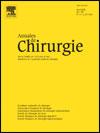Diverticule de Zenker : diverticulopexie contre diverticulectomie - 01/01/01
J.
Leporrier,
E.
Salamé,
M.
Gignoux,
P.
Ségol Correspondance et tirés à part
Correspondance et tirés à part
Résumé |
But de l'étude : Quarante patients opérés d'un diverticule pharyngo-oesophagien entre 1988 et 1998 ont fait l'objet de cette étude rétrospective non randomisée, dont l'objectif était de comparer les résultats obtenus par diverticulopexie ou diverticulectomie.
Patients et méthode : La série était composée de 23 hommes et 17 femmes avec un âge moyen de 72 ans. Trente-neuf patients ont pu être évalués. L'intervention a consisté 38 fois en une myotomie du cricopharyngien associée 19 fois à une diverticulectomie, et 19 fois à une diverticulopexie. Un patient a été opéré par diverticulectomie seule.
Résultats : La mortalité fut nulle et la morbidité postopératoire faible : une fistule résolutive sous traitement médical, une pneumopathie postopératoire, trois dysphonies transitoires et une reprise chirurgicale pour hématome compressif. Le résultat obtenu a été considéré comme excellent dans 36 cas, et moyen dans trois cas.
Conclusion : La myotomie du cricopharyngien associée à une diverticulopexie est particulièrement adaptée aux patients âgés et souvent fragiles, en particulier sur le plan respiratoire. La diverticulectomie est indiquée en cas de volumineux diverticule (diamètre > 6 cm) ainsi que chez le sujet jeune en raison du risque de dégénérescence.
Mots clés : diverticule pharyngo-oesophagien ; diverticulectomie ; diverticulopexie.
Abstract |
Study aim: The aim of this retrospective, nonrandomized study was to compare the results of diverticulectomy and diverticulopexy in the treatment of Zenker's diverticulum. Over the 10-year period between 1988 and 1998, surgery for Zenker's diverticulum was performed in 40 patients.
Patients and method: The study group consisted of 23 men and 17 women with a mean age of 72 years. Only 39 patients were evaluated. In 19 patients, treatment consisted of cricopharyngeal myotomy and diverticulum suspension; in the other 19 patients, treatment consisted of diverticulectomy in addition to myotomy. Only one patient had a diverticulectomy without myotomy.
Results: There was no mortality and the morbidity rate was low: one fistula, one pneumonia, three cases of transient dysphonia and one hematoma. The results were excellent in 36 patients, and good in 3 patients.
Conclusion: Cricopharyngeal myotomy with diverticulopexy is particularly suitable for geriatric patients. Diverticulectomy is proposed in the case of a diverticulum larger than 6 cm and for young patients to prevent the risk of malignant transformation.
Mots clés : diverticulectomy ; diverticulopexy ; pharyngoesophageal diverticulum.
Plan
Vol 126 - N° 1
P. 42-45 - février 2001 Retour au numéroBienvenue sur EM-consulte, la référence des professionnels de santé.

